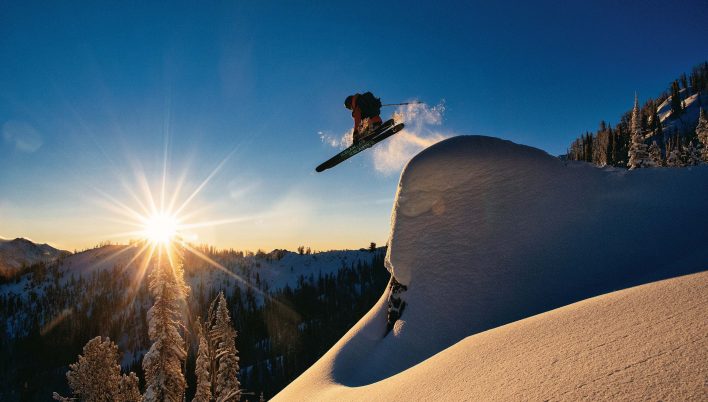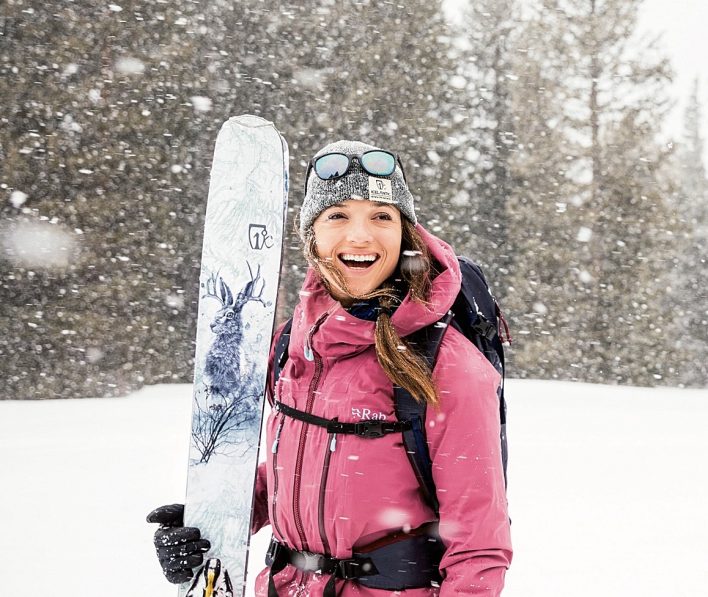As told by Amy Jane David
By 18, Amy Jane David had accrued accolades few might expect of the backflip-hucking American Institute for Avalanche Research and Education (AIARE) instructor featured in Teton Gravity Research films. Those included presenting research with her best friend, Jayne Thompson, at the International Snow Science Workshop—the world’s largest conference on snow and avalanches—and being Miss Wyoming Teen USA. Since then, she has been an on-camera host for the Freeride World Tour, curated adventure-based multimedia content, guided backpacking in Idaho’s Sawtooth Mountains and led backcountry retreats that focused on empowering women. David freely admits that the diversity of her roles—many of which she holds at once—isn’t an easy balance. But embracing all her identities is exactly what she wants to be doing. Now 31, she is pursuing her dream of starring in ski films and working toward her American Mountain Guides Association ski guide certification…while side-hustling to make it all possible. —Greta Close

In general, having held so many different roles, I think it can be confusing to other people. They’re like, “I can’t figure out, are you this or are you that?” I believe that I can be both. When people find out I was Miss Wyoming Teen USA, sometimes they’ll just attach to that and think, “Oh, you fit in the model box.” Well, no, that was one thing that I did. I also have this other breadth of experience and interests as well. So, I started to take more control of my story, embracing the different identities and sharing my story more clearly.
My boyfriend was killed in a cliff-jumping accident, and that really shaped a lot of my life. That same year, I had a life threatening ski crash. Everything just hit a lot harder. I put all my energy into my passions and what made me happy. I started to actually pitch myself to companies to be a sponsored skier. I opened myself up, and those opportunities started to come to me.
I hope that I can be a positive role model, as far as somebody who’s in front of the camera, someone who’s pushing myself and also doing it in a more tactful way. I found that to get into those positions, I’ve had to find those opportunities and create them myself. And so hopefully I’m opening the door for more people to then be able to create those opportunities down the line.
Growing up in Pinedale, [Wyoming], my exposure to the ski industry involved family days at the small White Pine Ski Area. Once I saw my first ski movie as a teenager, I fell in love with Rachael Burks. I thought she was so cool. She was pretty untethered. I also really connected with Lynsey Dyer; I really connected with her TED Talk, “Ski Like a Girl.” She was talking about working through her fears and the way that other people talked to her just because she was a girl. In her mind, she’s like, “Well, skiing like a girl is not a bad thing,” and that resonated with me.

I like to compare women in outdoor sports to wildflowers. Wildflowers are really beautiful, delicate and bring a lot of joy and happiness to the environment that they’re part of. But they’re also really hardcore. They can withstand the elements and thrive up in the mountains. I think women can embrace their femininity—if they want to. It’s not everyone’s thing. I could curl my hair and do my nails and get on my mountain bike and crush.
I’ve partnered with one of my mentors, Margaret Wheeler. She mentored me in avalanche education and guiding. And [now] I mentor her in snowmobiling. We teamed up to organize several all-women’s avalanche education courses. I want to continue making a space where people feel welcome in the ski industry. The film side of my career is more focused on creating opportunities for myself. The guiding and avalanche education side is about me trying to open the space for other people to feel welcome to learn.
I would like for more athletes to also get on board with contributing to the community that’s funding our careers as athletes. How are we giving back to the regular skiers? The majority of skiers in the world are not pros, but they’re the ones that are making this industry go ’round. So how can we be part of that?
I think that’s why I was drawn to each of them [Burks, Dyer and Wheeler]. The different passions that I have in my life and how I’ve weaved these different things into one career—from being an athlete in front of the camera to being a guide and an educator where I’m bringing other people into the sport and fostering their passion and education.
As I grew older, with new life experiences, I’ve felt a deep appreciation for Angel Collinson and her openness to share the raw emotions of the human experience. After I experienced the death of someone I deeply loved, I looked to her to hear how she processed and continues to flow with grief. I’ve felt a spiritual connection to the mountains through moments of sorrow while finding peace and joy simultaneously. Skiing is something that elicits endorphins and childlike laughter and has helped me overcome internal challenges. This is the greatest evolution for me—not just the evolution of progress, but the evolution of always returning to the core of why I love the mountains and skiing. When the industry, clout and media falls away, what do you have in your heart?
I wish more people in the world were able to pursue their passions. That being said, I have to hustle a lot to make ends meet. I’ve looked at it like, I could get a job that pays a lot of money and then have a couple of weeks each year to go and do whatever I want, or I can take a little bit less money and have a job that I love and get to spend most of my time doing what I love. And that’s what I chose. My overall happiness is much greater because of that, because I get to spend my time outside, helping people and pursuing the thing that makes me happy.
This interview first appeared in Issue 149. To pick up a copy, go to BackcountryMagazine.com/149. Many of our articles are only publishing in print and never make it online, so to read stories earlier and see all our work, subscribe.










Related posts: